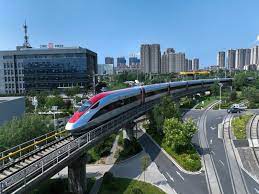Courtesy : en.wikipedia.org/wiki/High-speed
High speed rail
High-speed rail (HSR) is a type of rail system that runs significantly faster than traditional rail, using an integrated system of specialised rolling stock and dedicated tracks. While there is no single standard that applies worldwide, lines built to handle speeds above 250 km/h (155 mph) or upgraded lines in excess of 200 km/h (124 mph) are widely considered to be high-speed.The first high-speed rail system, the Tōkaidō Shinkansen, began operations in Japan in 1964 and was widely known as the bullet train.
High-speed trains mostly operate on standard gauge tracks of continuously welded rail on grade-separated rights of way with large radii. However, certain regions with wider legacy railways, including Russia and Uzbekistan, have sought to develop a high speed railway network in Russian gauge. There are no narrow gauge high-speed trains; the fastest is the Cape gauge Spirit of Queensland at 160 km/h (99 mph).
Many countries have developed, or are currently building, high-speed rail infrastructure to connect major cities, including Austria, Belgium, China, Denmark, Finland, France, Germany, Indonesia, Italy, Japan, Morocco, the Netherlands, Norway, Poland, Portugal, Russia, Saudi Arabia, Serbia, South Korea, Spain, Sweden, Switzerland, Taiwan, Turkey, the United Kingdom, the United States, and Uzbekistan. Only in continental Europe and Asia does high-speed rail cross international borders.
High-speed rail is the fastest and most efficient ground-based method of commercial transportation, however due to requirements for large track curves, gentle gradients and grade separated track the construction of high-speed rail is more costly than conventional rail and therefore does not always present an economical advantage over conventional speed rail. China currently accounts for over two-thirds of the world’s total high speed rail, with over 37,900 km (23,500 mi) of high speed rail on their networks.
Definition
See also: Passenger rail terminology
Multiple definitions for high-speed rail are in use worldwide.
The European Union Directive 96/48/EC, Annex 1 (see also Trans-European high-speed rail network) defines high-speed rail in terms of:Infrastructuretrack built specially for high-speed travel or specially upgraded for high-speed travel.Minimum speed limitMinimum speed of 250 km/h (155 mph) on lines specially built for high speed and of about 200 km/h (124 mph) on existing lines which have been specially upgraded. This must apply to at least one section of the line. Rolling stock must be able to reach a speed of at least 200 km/h to be considered high speed.Operating conditionsRolling stock must be designed alongside its infrastructure for complete compatibility, safety and quality of service.
The International Union of Railways (UIC) identifies three categories of high-speed rail:Category INew tracks specially constructed for high speeds, allowing a maximum running speed of at least 250 km/h (155 mph).Category IIExisting tracks specially upgraded for high speeds, allowing a maximum running speed of at least 200 km/h (124 mph).Category IIIExisting tracks specially upgraded for high speeds, allowing a maximum running speed of at least 200 km/h, but with some sections having a lower allowable speed (for example due to topographic constraints, or passage through urban areas).
A third definition of high-speed and very high-speed rail (Demiridis & Pyrgidis 2012) requires simultaneous fulfilment of the following two conditions:
- Maximum achievable running speed in excess of 200 km/h (124 mph), or 250 km/h (155 mph) for very high-speed,
- Average running speed across the corridor in excess of 150 km/h (93 mph), or 200 km/h (124 mph) for very high-speed.
The UIC prefers to use “definitions” (plural) because they consider that there is no single standard definition of high-speed rail, nor even standard usage of the terms (“high speed”, or “very high speed”). They make use of the European EC Directive 96/48, stating that high speed is a combination of all the elements which constitute the system: infrastructure, rolling stock and operating conditions. The International Union of Railways states that high-speed rail is a set of unique features, not merely a train travelling above a particular speed. Many conventionally hauled trains are able to reach 200 km/h (124 mph) in commercial service but are not considered to be high-speed trains. These include the French SNCF Intercités and German DB IC.
The criterion of 200 km/h (124 mph) is selected for several reasons; above this speed, the impacts of geometric defects are intensified, track adhesion is decreased, aerodynamic resistance is greatly increased, pressure fluctuations within tunnels cause passenger discomfort, and it becomes difficult for drivers to identify trackside signalling. Standard signaling equipment is often limited to speeds below 200 km/h (124 mph), with the traditional limits of 127 km/h (79 mph) in the US, 160 km/h (99 mph) in Germany and 125 mph (201 km/h) in Britain. Above those speeds positive train control or the European Train Control System becomes necessary or legally mandatory.
National domestic standards may vary from the international ones.





